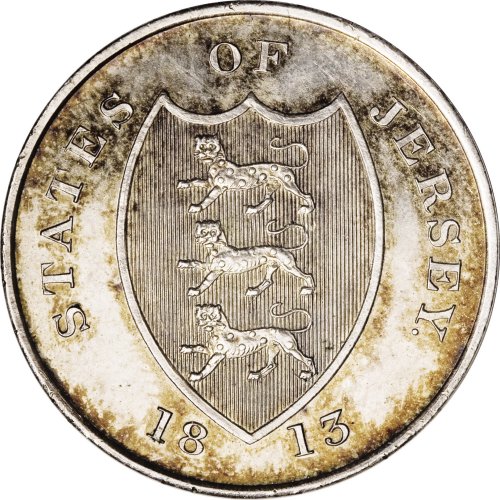(click on image to enlarge)


| Eighteen Pence (click on image to enlarge) | |
|---|---|
 |
 |
| The Jersey 18 Pence designed and engraved by Thomas Wyon | |
Silver. Three Shillings and Eighteen Pence for the years from 1812 to 1816, the obverse design being by Marchant but the dies cut by Thomas Wyon Jr., who both designed and cut the reverses of the Eighteen pence. These pieces are some of the Bank Tokens mentioned above. Half Crown, Shilling and Sixpence for various years from 1816 to 1820, his dies being used after his death. The obverses of these pieces were designed by Pistrucci but Thomas Wyon Jr. engraved them and designed and engraved the reverses.As stated earlier the obverse of the first Half Crown had been designed by Pistrucci and adapted by Thomas Wyon Jr. In 1813 and 1816 he engraved the dies for the coinage issued for British Guiana in silver and copper, and in 1813, 1814 and 1815 the dies for the gold and silver Pistoles and Gulden for be remembered that our kings from George I to William IV inclusive (the House of Hanover) were Dukes of Brunswick and Luneburg, Arch-Treasurers of the Holy Roman Empire and Electors. The titles and form of government there changed over the period, due in part to the Napoleonic Wars. Thomas Wyon Jr. also cut dies for coins for Ceylon, Ireland and Jersey and for an unexpected piece, the gold Twenty Francs of 1815. This showed the bust of Louis XVIII on the obverse and the arms of France on the reverse. These pieces, 871,581 of which Council dated 10 May 1815, and were used to pay the troops serving under the Duke of Wellington. Wyon engraved numerous dies for patterns for both the British Imperial and British Colonial coins.
Proof of the head of the Half Crown of George III., a work by T. Wyon, Chief-engraver at the Mint, and retouched by me with the diamond point. This head was copied from one of my cameos preserved at the Mint, but was never issued, the puncheons of the said head, retouched by me, were burnt several times at the Mint. They are extremely rare, as although they resemble the Half Crowns in circulation, they differ in the face, which on the common coins is more morbid. Given to me by Mr. Pole. B. Pistrucci.